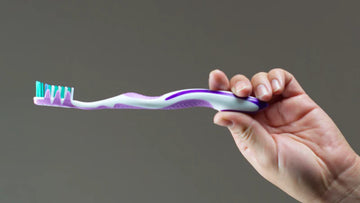Polylactic Acid (PLA) is the brand new kid on the block for many “eco-friendly” brands. This petroleum-plastic alternative is touted for its biodegradable and compostable properties and used in packaging for the food industry, cutlery, shampoo and water bottles, film and, most recently, in the toothbrushes and bristles of “environmentally conscious” oral care companies such as Jack and Jill, Humble Brush, SimpliGood and Re-Brush.
You might have noticed, though, that RADIUS is not on that list of ‘eco-friendly’ oral care companies that use PLA in their products....why?
At RADIUS, we pride ourselves on using materials that we feel are good for your teeth and good for our earth. We feel that PLA is not one of those materials.
In this article, we’ll discuss what PLA is, why it’s not as eco-friendly as it seems, and what we at RADIUS use as a more eco-conscious alternative to PLA.
WHAT IS PLA?
PLA is a polymer created through the fermentation of cornstarch, sugarcane, or sugarbeets. This process of fermentation produces lactic acid monomers which, when combined, make PLA. PLA is often marketed as the biodegradable and compostable alternative to petroleum-based plastics. It is also manufactured with non-toxic renewable resources, making it less harmful than petroleum-based plastic.
Those factors make PLA really enticing. So, what makes it so bad?
WHY PLA HAS A TENUOUS CLAIM TO “BIODEGRADABLE” AND “COMPOSTABLE”
First of all, let’s talk about the difference between ‘biodegradable’ and ‘compostable’. For the purposes of this article, we’ll be using the definitions of these terms according to ASTM International, the organization which sets international technical standards for materials, products, systems and services.
ASTM International states that a biodegradable material is one that degrades as a result of naturally occurring microorganisms. A compostable material, on the other hand, also degrades as a result of naturally biological processes but also produces CO2, water, inorganic compounds and biomass at a rate consistent with other compostable materials AND, most importantly, leaves no visible or toxic residue.
Translation: compostable is a type of biodegradable (i.e. all compostable products are biodegradable, but not all biodegradable products are compostable). Compostable materials basically biodegrade in a particular environment and can actually be useful for the environment they biodegrades in. So, if possible, you want your product to not only be biodegradable, but be compostable.
So, is PLA really compostable?

According to the ASTM International standard (ASTM 6400) used to claim biodegradability and compostability for plastic products in the USA: yes...with conditions.
This standard examines soil toxicity, disintegration, heavy metals and biodegradability. In order to pass this standard, 90% of the material must eventually convert to CO2 within 6 months. By that standard, PLA is compostable and biodegradable….but only in a very specific type of environment: one that has very specific oxygen levels and has temperatures that exceed 140°F. This only occurs in industrial compost environments. In fact, companies that produce PLA products are only allowed to claim adherence to this ASTM International standard if, and only if, the company adds an addendum that specifies that the PLA product will only degrade in an industrial compost environment.
PLA is often considered an “unidentifiable plastic” and can contaminate other plastics if recycled improperly. Therefore, many industrial compost facilities do not accept PLA products. In the U.S., there are just over 50 facilities that have a permit to compost PLA, making it difficult for most PLA-producing companies to access these facilities. Companies requiring PLA disposal will often have to pay for an outside service in order to deal with their PLA waste.
So, what happens if a PLA product ends up in an environment that is not an industrial compost environment? It can actually take a hundred to a thousand years to decompose.
Not great.
Not only that, it is rumored that the reason ASTM 6400 (the aforementioned standard used to test the biodegradability of PLA in industrial facilities) is the only test in the USA that allows companies to claim “biodegradable/ compostable” on the packaging is because PLA (a corn-based product) is backed by large agricultural lobbyists. As a result, brands who want to claim “biodegradable/ compostable” on their packaging are forced to use PLA as a shortcut, even though it is not readily biodegradable and compostable in standard recycling and compost facilities.
There is one more primary reason why PLA is not always compatible with compostability.
PLA is very, very fragile.
PLA is less durable, crystalline, and heat resistant than petroleum-based plastic and even bioplastic counterparts. As a result, more often than not, it needs to be blended with petroleum-based polymers in order to strengthen it for use. This means that while PLA in itself is compostable, what it is blended with may render its composting properties completely moot.
If PLA is not as biodegradable or compostable as other bioplastics, why do companies use it?
Simple: It costs less. PLA is very inexpensive to produce and can cost roughly the same or even less than petroleum-based plastics. If a company can meet the ASTM International standard on their products, even with the addendum, they can then classify themselves as an “eco-friendly” company without the exorbitant price tag.
OTHER ISSUES WITH PLA
By now, we know that PLA is not the compostable poster child it seems to be, but are there other eco issues with PLA? You bet your heiny. Here are a few other common issues:
- Fertilizers and pesticides used in growing the materials that make up PLA release large amounts of nitrous oxide, one of the “big 4” greenhouse gases that is 310% more potent that carbon dioxide
- PLA requires a lot of land to produce. The Plastic Pollution Coalition estimated that 3.4 million acres would be needed in order to produce enough PLA to meet global demand. This would take away land needed for other important functions...like growing food. Plastics vs. food? We’ll take the food.
- Due to its fragility, PLA is not meant to last long term and is often used for single-use products. Single use plastics = more plastic waste.
- Since PLA is not often properly disposed of, but labeled as an eco-ethical choice, companies with this label are often deceiving their customers into believing that they are being environmentally responsible, when this is not entirely true.
WHAT WE AT RADIUS USE
By now, you might have a pretty good idea of why we chose not to use PLA in our products....so what do we use instead?

Our plastics are culled from upcycled, renewable resources to create sturdy, sustainable bioplastics. To ensure that our products are 100% biodegradable and compostable, we’ve recently made the move to use EcoPure® in all of our plastic products. EcoPure® is an organic additive that is added to plastics that helps plastics biodegrade more quickly in all landfills. To give you an example of this, when EcoPure® is added to polyolefin plastic (a popularly used bioplastic), plastic degrades at a rate of 40.2% over a period of 385 days. Without this additive, that same plastic would only degrade at a rate of 3.2% over that same time period.
You can read more about the measures we are taking to maximize the eco-friendliness of our products in this article.
And be sure to try our PLA-free products for yourself!

